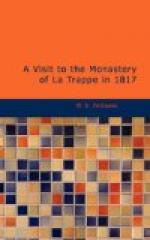I entered Paris, leaving Bicetre to my right, by the barriere d’Enfer, after one of the most agreeable and interesting journeys I ever performed.
CHAP. IX.
ENVIRONS OF PARIS—PERE LA CHAISE—CASTLE OF VINCENNES—AND CHATEAU OF ST. GERMAIN—ITS FOREST AND VICINITY.
Prior to the revolution, the French, like most other European nations, were in the practice of depositing their dead in churches and cemeteries within the most populous towns, in compliance with those precepts of evangelical doctrine which recommend us unceasingly to reflect on death; and hence originated a custom which cannot but be attended with most pernicious consequences to health, when we reflect that the decomposition of human bodies is productive of putrid exhalations, and consequently pregnant with the causes of contagious disorders. It is indeed surprising that some regulations have not hitherto been adopted in England regarding the interment of the dead, from the example of other countries.
In the year 1793, a decree was passed by the National Assembly, to prevent burying in churches, or in church-yards, within the city of Paris. Since which period, there have been three places selected in its immediate neighbourhood for that purpose—Montmartre, called “Le Champ du Repos”—Vaugirard, and Pere La Chaise.
Quitting the Boulevards, at the extremity of the Boulevards Neufs, eastward of the city, and passing through the Barriere d’Aulnay, I arrived at the Pere La Chaise. At the entrance, through large folding gates, is a spacious court-yard, having at one angle the dwelling of the Concierge, or Keeper. The enclosure contains one hundred and twenty acres, on a gently rising ground, in the centre of which stands the ancient mansion constructed by Louis XIV. for his confessor, Pere la Chaise, the celebrated Jesuit, who, with Madame de Maintenon, governed France. Rising above the thousands of tombs which surround it, it displays itself a wrecked and mouldering monument of ancient splendour, and the mutability of human affairs! This spot became afterwards a place of public promenade and great resort, from the beauty of its position overlooking all Paris; and though so often the scene of festivity and pleasure, now presents to the eye of the beholder a mournfully interesting sight of tombs and sarcophagi, intermixed with various fruit trees, cypress groves, the choicest flowers, and rarest shrubs.
From the rising ground, above the building of Pere La Chaise, a most delightful view displays itself. The city of Paris appears to stand in the centre of a vast amphitheatre. The heights of Belleville, Montmartre, and Menilmontant, in the west. To the east, the beautiful plain of Saint-Mande, Montreuil, and Vincennes, with the lofty towers of its fortress.—The fertile banks of the river Marne, are on the North, and in the South, the horizon encircles Bicetre and Meudon.




